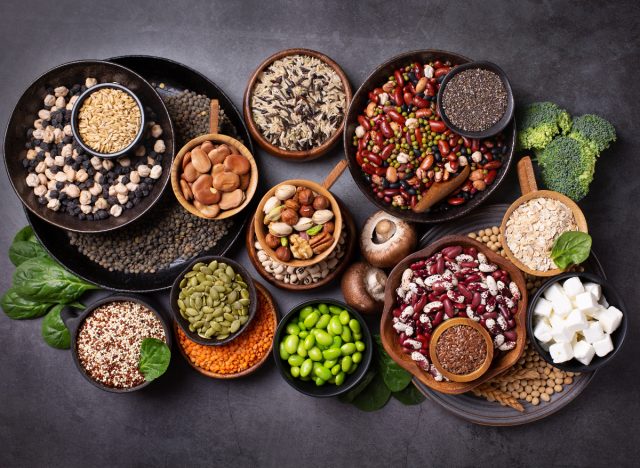Athletes, bodybuilders, and powerlifters know something that the rest of the world probably doesn’t: What you eat is just as important as how you train—if not more. Food is fuel, and choosing the right type of fuel is critical to how efficiently you build muscle and strength.
“There are three main components you need to fast-track muscle growth,” says registered dietitian Amy Goodson, MS, RD. And two of them involve a knife and fork.
“You need adequate calories—and even a calorie surplus if you want to gain muscle and weight—adequate protein, and strength training,” says Goodson, author of The Sports Nutrition Playbook and a certified specialist in sports dietetics who has worked with the Dallas Cowboys and Texas Rangers.
Read on to discover key eating habits that will supply your body with the fuel to power your workouts and fast-track muscle growth. And if you’re looking for a muscle-building workout, check out The #1 Strength Workout to Regain Muscle as You Age.


Not all proteins are created equal. You want to target a “complete” protein. “A high-quality protein means that the protein contains all nine of the essential amino acids that your body cannot make on its own,” says Goodson. These nine essential amino acids are necessary for building and repairing lean muscle mass. Sources of complete proteins include animal foods like beef, pork, poultry, fish, dairy, and eggs.


A few plant-based proteins like soy foods, quinoa, hemp seeds, and pistachios are considered complete plant-based proteins. Other plant-based proteins like beans, legumes, lentils, other nuts and seeds, and nut butters are “incomplete” proteins, meaning they do not contain all nine of the essential amino acids. “Does this mean you can’t gain muscle if you eat plant-based? No, but it does mean that you need to be strategic with your protein intake and eat a variety of plant-based proteins to ensure you are getting all the essential amino acids that your body cannot make,” says Goodson.


Animal proteins are more bioavailable than plant proteins. That’s because plant foods contain fiber and other compounds that compete with protein for absorption, Goodson tells us. If you’re eating a 100% plant-based diet, she recommends consuming a little more protein than normal to ensure that you are getting an adequate amount.
READ RELATED: Matt Willis reveals he became 'addicted' to working out to cope with drug and alcohol struggles
What constitutes an adequate amount?
The optimum number of grams of protein to consume at a meal depends on your body size and the type of physical activity or sport you do. Research suggests that about 30 grams of protein per meal will provide your body with what it needs for muscle repair and growth, and promote feelings of fullness and satiety that will keep you from overeating. Be sure to include protein snacks throughout the day.
“The important thing to remember is that that excessive protein does not mean more muscle mass,” says Goodson. “Eat that amount of protein you need, and distribute it over the course of the day over all meals and snacks, but balance that with high-quality carbohydrates and healthy fats.”
Best times to eat protein to fast-track muscle
In addition to eating protein at every meal and snack, have some protein after your workouts. “Consume between 15 and 25 grams of high-quality protein as soon as possible after a workout, ideally within 45 minutes or so,” says Goodson. “Larger athletes can go up to 40 grams of protein, but research suggests that over about 40 grams, the body is no longer using it for muscle synthesis and will just convert it into energy.”
For the best post-workout protein hit, choose a shake or protein bar made with whey protein. Whey protein is one of the quickest digesting proteins and is naturally rich in the branch chain amino acid leucine. “Leucine is really the ‘light switch’ to muscle resynthesis,” says Goodson. “Pairing about 20 grams of whey protein with a quick digesting carbohydrate is ideal for recovery.” Good examples include a shake made with whey protein; milk and fruit; low-fat chocolate milk; or a protein bar with 15 to 25 grams of whey protein. You can also try these recipes for the Best Protein Smoothies for Stronger Muscles.
Other ways to get more muscle-building protein
Protein supplements like protein powders are a convenient and easy way to get protein in, especially after a workout when food may not be readily available. In addition, protein powders can help add protein to foods not naturally high in protein. “Adding protein powder to oatmeal for example is a great way to boost your protein intake at breakfast, adding collagen powder to your coffee can provide amino acids to kick off the day, and you can even use protein powders when baking things like muffins, breads, and making pancakes,” says Goodson. “Unflavored whey protein can typically replace half the flour in a recipe without changing the texture or integrity of the food item.”
Jeff Csatari
editing Galvanized Media books and magazines and for advising journalism
students through the Zinczenko New Media Center at Moravian University in Bethlehem, PA. Read more about Jeff
Source:











